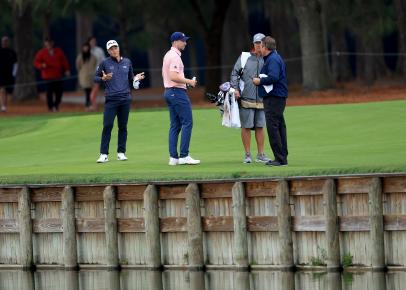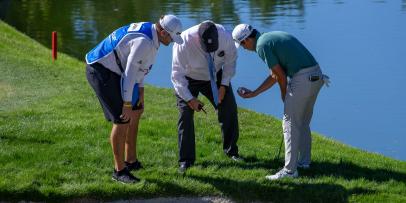Rules
The PGA Tour is debuting a new approach to monitoring rules, and most players probably don't know about it

The PGA Tour's new rules studio is making its debut this week at the Farmers Insurance Open.
SAN DIEGO — There will be a day a couple of years from now when we’ll watch PGA Tour coverage and hear a phrase that sounds like those constantly uttered in other professional sports when officials need help with a rules call: “They're taking a look in Ponte Vedra.”
Just as the NFL has its replay center in New York, and the NHL in Toronto, and the NBA in Secaucus, N.J., the PGA Tour plans to have its own rules hub at its headquarters in Ponte Vedra, Fla., beginning with the 2025 season.
Until then, on-site broadcast rules officials Mark Dusbabek and Orlando Pope will be housed in a studio that is making its debut this week for the Farmers Insurance Open. In a production truck parked on a dusty lot in the television compound near the cliffs at Torrey Pines, a tour milestone will be reached during CBS’ coverage of the last two rounds on Friday and Saturday.
Rather remarkably, considering the remote rules work being done in most professional sports, PGA Tour rules officials will for the first time have their own dedicated space in which to do their jobs. In a small, darkened room with banks of screens, Dusbabek and Pope will be able to monitor any shot that is shown by PGA Tour Live, CBS and NBC.
For several years, officials have watched the network broadcasts from various spots, including any office cubby they could find or sitting in the network tower at the 18th hole, trying to be as inconspicuous as possible as anchors Jim Nantz and Dan Hicks performed their commentary. But that was more about Dusbabek and Co. being able to comment on rulings and less about scrutinizing every shot for a potential violation. And that just didn’t seem acceptable in the age of cameras installed in football yardage markers and tennis being refereed completely by computers.
“Golf is a different sport. It’s a game or honor and a game of etiquette. That differentiates us from other sports,” said Dusbabek, the tour’s senior director of TV rules. “But there’s a lot more riding on things now, and this brings us into an equal basis with the other sports. The way the game has risen, this is what needs to happen. It’s the direction we need to go.”
Under the new system, either Dusbabek or Pope will be on-site for 28 tournaments in 2023 that will be shown on CBS or NBC. For the first two rounds, the pair will continue to be part of the squad of about 10 officials who roam the course each day to assist with any rules situation. (There are 15 this week to cover the two Torrey Pines courses.) Then, for the final two rounds, they will monitor every shot that is shown on either PGA Tour Live or the network. (Golf Channel is not included as a “partner” in this endeavor.)
Using a system developed by Hawk-Eye Innovations, a monitoring official in the truck can find a single shot by a specific player on a specific hole, make a clip of it and share it with others—all in less than a minute.
The goals in the process are expediency and accuracy. Dusbabek cites an example by which he’d see a player drive his ball against a fence. He'd then immediately contact the rules official closest to the hole to let him know that a ruling might be upcoming. That’s quite a difference from the old days, when a player arrived at his ball, contemplated (sometimes slowly) his options and then call for a rules official. That kind of situation killed the pace of play and frustrated TV producers who are trying to finish in their allotted time slot.
The ability to respond to potential rules violation is even more important, and the tour’s belief in the new system was confirmed at last year’s Players Championship, where more monitoring was being tried and two specific incidents came up. In the first one, Paul Casey questioned whether his ball ended up in his own pitch mark (it had not). The second saw Keegan Bradley penalized two strokes for replacing his ball on the green after the wind blew it away from his mark. (In that case, Bradley marked the ball in the new spot when he should have re-marked it in the original place.)
In both rulings, Dusbabek immediately recognized the issues on his TV screen and was able to notify the on-course officials. Both Casey and Bradley were quickly informed, rather than possibly hearing about problems several holes later or after the round.

Mark Dusbabek will come in off the course and oversee the PGA Tour's new rules review process.
Stanley Chou
“When you think about it for the player, he may have a two-stroke penalty added to his score, but he’s waiting for two or three holes to know that,” Dusbabek said. “The sooner you get it to him, the better, and he’s going to be able to figure out how to play the rest of his round. That provides an extra service to the players.”
It’s almost guaranteed that most players in the 156-man field for the Farmers this week know nothing about this latest tour milestone because it’s been a quiet progression to this point. Dusbabek, 58, a Minnestota grad who played three years at linebacker in the NFL and has been with the tour for 18 years, began about a decade ago pressing for officials to have a voice on broadcasts because he heard comments by commentators or players that were misguided or simply not true. That was a problem, because it confused viewers and opened up the sport to criticism that it’s too fussy with its rules. Additionally, it was a bad look years ago when a guy sitting on his couch who called tour HQ was identified as the source for a rules judgement. “Ninety-nine percent of those were bogus,” Dusbabek says now.
The tour dipped its toes into on-air rules commentary a few years ago at events such as the Players Championship, WGC-Dell Match Play and Presidents Cup. But it wasn’t until 2021—in what turned out to be strange and fortuitous timing at the Farmers—that a larger on-air presence was put into place. That was the year that eventual winner Patrick Reed stirred up controversy by taking a drop from an embedded lie he said he believed was caused by his own ball. In the moment, Ken Tackett was the TV rules official put on the hot seat for clarification by CBS’s Nantz and Nick Faldo. (On the ground, official Brad Fabel ultimately was satisfied with Reed's explanation for how he played it, and there was no penalty applied.)
“If you look at that scenario, as crazy as the whole thing was, how great was it to have someone assigned to TV rules sit there and talk to Jim about what the decision was and why?” Dusbabek said.
In the NFL, rules analysts have become household names, and some fans probably would recognize Gene Steratore and Mike Perreira more readily than a few of the league’s head coaches. Michael Baliker, a member of the PGA Tour communications team, laughed when he recalled Tackett receiving a rousing ovation on the first tee of the Presidents Cup when he was introduced as a match official. “The place erupted,” Baliker said, “and that’s when I thought, ‘Oh my gosh, this is where we are. These guys are starting to become known on the telecast.’”
Dusbabek sheepishly admitted he’s being recognized in public, but his face turned more serious in emphasizing the purpose of his very existence on the broadcasts.
“None of us is doing it for the notoriety,” he said. “We do it for the game we love. We do it for the PGA Tour and for the betterment of the sport. We’re trying to provide more for the partners and more for the PGA Tour. I’m grateful for how they’ve embraced it. … We’re growing fast and it’s getting bigger and better.”
With a subtle nod toward upstart LIV Golf, he added, “With all of the things going on [in golf], we’re setting ourselves apart from everybody else.”


